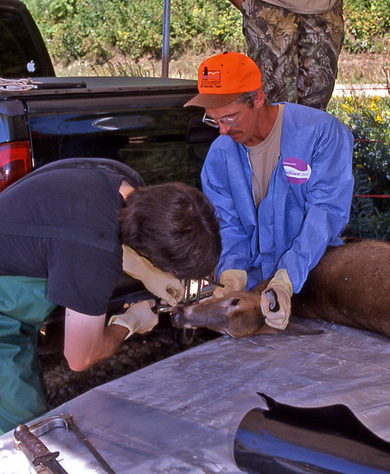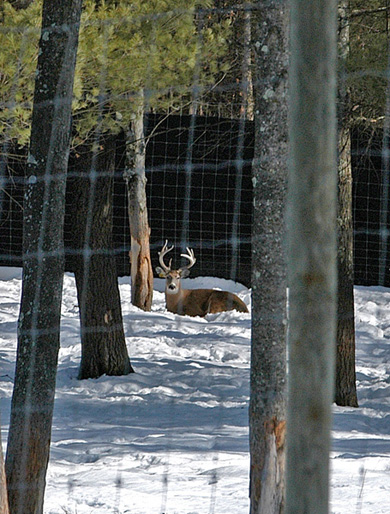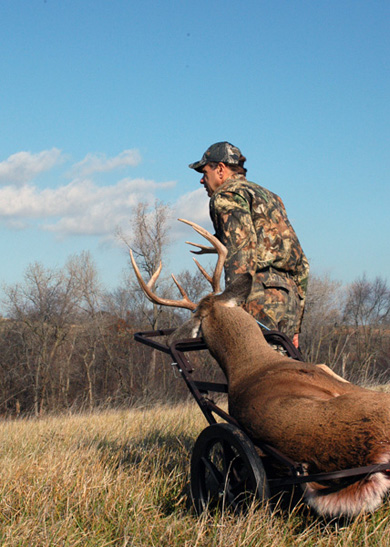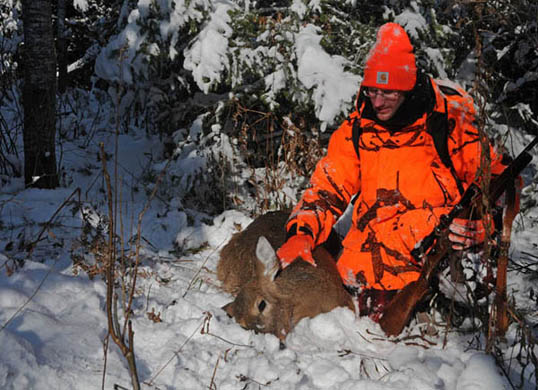LAST UPDATED: May 1st, 2015
Despite testing a record-low number of deer for chronic wasting disease in 2013, the Department of Natural Resources has already verified a record 350 CWD-positive cases during the annual collection period that ends March 31. The DNR has collected 4,319 deer samples since April 1, 2013, or 9 percent fewer than it sampled during the 2012 collection period (4,747). Even so, the 350 new cases are already 17 more (5 percent) than the agency confirmed in 2012. Further, the 2013 samples are 11 percent fewer than collected in 2011 (4,876), yet delivered 47 percent more positive cases (238) than two years ago. It’s likely the DNR will collect more samples and identify more CWD cases during March as hunters comb the woods for shed deer antlers, a popular spring hobby. Also, turkey hunters will soon start scouting in preparation for the April-May hunting season.
During 2013, CWD’s infection rates increased in the state’s core disease areas and spread farther into areas new to the disease.
Those escalating numbers don’t surprise Tami Ryan, the DNR’s section chief in wildlife health. “The disease continues to increase in prevalence, incidence and geographic distribution,” she said Tuesday. “It’s not surprising because we’re simply monitoring the disease.” In CWD’s core area west of Madison, disease rates set records again during the 2013 hunting seasons. For bucks 2.5 years and older, 24 percent had the disease, up from 8 percent in 2002 and from 22.5 percent in 2012. In females 2.5 and older, nearly 11 percent had the disease, up from 3 percent in 2002 and from 9.5 percent in 2012. In 1.5-year-old deer, the rates were 7.5 percent for bucks, up from 1.8 percent in 2002 and from 6.5 percent in 2012; and 6.5 percent for does (3 percent, 2002; 5.5 percent in 2012). CWD rates aren’t as high in the state’s southeastern counties, but they still pushed to record highs: 7 percent for bucks 2.5 and older, 3 percent for does 2.5 and older, 2.5 percent for yearling bucks, and 2.4 percent for yearling does.
Two deer tested positive in 2013 on a central Wisconsin property next door to a former deer farm that had an 80 percent infection rate, North America’s greatest concentration of CWD.
Meanwhile, the DNR found two more cases of CWD along the Wisconsin River corridor in central Wisconsin. Three deer killed near the river in 2012 had CWD; one each in Adams, Juneau and Portage counties. A second Adams County deer tested positive in 2013, as did one in northwestern Portage County. Portage County’s two cases near the river northwest of Stevens Point were two miles and five miles from the Alligator Creek deer farm, which had two CWD cases in its captive herd in 2008. The state Department of Agriculture, Trade and Consumer Protection destroyed the 64-deer herd in November 2008. The DNR also found two CWD cases in bow-killed deer in southeastern Portage County between Plainfield and Almond in 2013. Both were on properties bordering the former Buckhorn Flats deer farm, the site of North America’s worst CWD case. When the U.S. Department of Agriculture destroyed the 76-deer herd in January 2006, 60 tested positive for CWD, a nearly 80 percent infection rate. The fenced property, operated by Stan Hall and owned by his girlfriend, Patricia Casey, is now DNR property but closed to public use because its 80 acres is likely contaminated with CWD-causing prions. In all, 82 of the farm’s deer tested positive for CWD between 2002 and 2006.
Even though Wisconsin tested fewer deer for CWD than ever before in 2013, it found a record 350 diseased deer.
The DNR has collected more than 3,580 samples from wild deer killed in surrounding townships since CWD was first detected at Buckhorn Flats. On Nov. 1, the agency reported its first case of CWD in a nearby wild deer, which fell Oct. 6 to an archer. The second case came from a nearby deer killed during December’s late-archery season. On Monday night, the DNR issued shooting permits to two neighboring landowners, authorizing them to shoot deer to collect more samples. The agency hopes other neighbors will also volunteer to shoot deer during March to help assess the site.
In northwestern Wisconsin, where a Washburn County deer tested positive two years ago, a second season passed without detecting a new case. Even though 499 deer within 10 miles of the 2012 case tested negative in 2013, Ryan said it’s too soon for optimism. “It’s unlikely we found the one and only CWD-positive deer in an area,” she said. “We had only one case of CWD in Richland County for several years before we found the next one, and now we’re seeing increasing trends in prevalence there. That’s the classic cautionary experience to remember.” The DNR has identified nearly 2,500 cases of CWD in wild deer in the 12 years since first finding it in three deer from the 2001 season. Nearly 46 percent (1,140) of the cases are from the past four years.
The public is reporting more sick deer in rural Wisconsin than in previous years.
Don Bates, the DNR’s CWD operations supervisor for southwestern Wisconsin, also reported increases in public reports of sick deer. Since 2009, his office in Dodgeville has received 53 reports of visibly sick deer in Iowa County alone, of which 32 tested positive for CWD. After confirming 12 cases from public reports from 2009 to 2011 in Iowa County, the agency confirmed 12 cases in 16 calls in 2012 and eight of 11 so far in the 2013 period. March is typically one of the busiest months for investigating sick-deer reports. Deer can look “ratty” as they emerge from winter and start shedding their thick hair, but increased outdoor recreation usually increases reports of sick deer.

 By
By 







